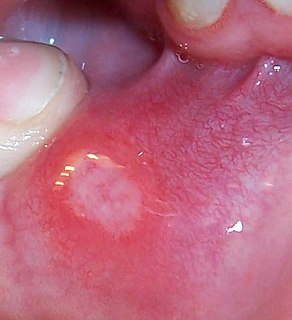
Ulcerative colitis (UC) is a long-term condition that results in inflammation and ulcers of the colon and rectum. The primary symptoms of active disease are abdominal pain and diarrhea mixed with blood. Weight loss, fever, and anemia may also occur. Often, symptoms come on slowly and can range from mild to severe. Symptoms typically occur intermittently with periods of no symptoms between flares. Complications may include megacolon, inflammation of the eye, joints, or liver, and colon cancer.

A mouth ulcer is an ulcer that occurs on the mucous membrane of the oral cavity. Mouth ulcers are very common, occurring in association with many diseases and by many different mechanisms, but usually there is no serious underlying cause.

Acute necrotizing ulcerative gingivitis (ANUG) is a common, non-contagious infection of the gums with sudden onset. The main features are painful, bleeding gums, and ulceration of inter-dental papillae. This disease, along with necrotizing (ulcerative) periodontitis is classified as a necrotizing periodontal disease, one of the seven general types of gum disease caused by inflammation of the gums (periodontitis).

Granuloma inguinale is a bacterial disease caused by Klebsiella granulomatis characterized by genital ulcers. It is endemic in many less-developed regions. It is also known as donovanosis, granuloma genitoinguinale, granuloma inguinale tropicum, granuloma venereum, granuloma venereum genitoinguinale, lupoid form of groin ulceration, serpiginous ulceration of the groin, ulcerating granuloma of the pudendum, and ulcerating sclerosing granuloma.

Inflammatory bowel disease (IBD) is a group of inflammatory conditions of the colon and small intestine. Crohn's disease and ulcerative colitis are the principal types of inflammatory bowel disease. Crohn's disease affects the small intestine and large intestine, as well as the mouth, esophagus, stomach and the anus, whereas ulcerative colitis primarily affects the colon and the rectum.

Colitis is an inflammation of the colon. Colitis may be acute and self-limited or long-term. It broadly fits into the category of digestive diseases.
Xerophthalmia is a medical condition in which the eye fails to produce tears. It may be caused by vitamin A deficiency, which is sometimes used to describe that condition, although there may be other causes.

Aphthous stomatitis is a common condition characterized by the repeated formation of benign and non-contagious mouth ulcers (aphthae) in otherwise healthy individuals. The informal term canker sores is also used, mainly in North America, although this may also refer to any mouth ulcers.

Pyoderma gangrenosum is a rare, inflammatory skin disease where painful pustules or nodules become ulcers that progressively grow. Pyoderma gangrenosum is not infectious.

Balsalazide is an anti-inflammatory drug used in the treatment of inflammatory bowel disease. It is sold under the brand names Giazo, Colazal in the US and Colazide in the UK. It is also sold in generic form in the US by several generic manufacturers.

Olsalazine is an anti-inflammatory drug used in the treatment of inflammatory bowel disease such as ulcerative colitis. It is sold under the name Dipentum.
Ustekinumab, sold under the brand name Stelara, is a human monoclonal antibody used to treat psoriasis. It is also approved to treat Crohn's disease in the United States, Israel and Australia, and ulcerative colitis in the U.S., and in the European Union (EU) among people who have not responded to more traditional treatments. It was found not effective for multiple sclerosis.
A stress ulcer is a single or multiple mucosal defect which can become complicated by upper gastrointestinal bleeding or physiologic stress. Ordinary peptic ulcers are found commonly in the gastric antrum and the duodenum whereas stress ulcers are found commonly in fundic mucosa and can be located anywhere within the stomach and proximal duodenum.
An ulcer is a discontinuity or break in a bodily membrane that impedes normal function of the affected organ. According to Robins pathology, "ulcer is the breach of the continuity of skin, epithelium or mucous membrane caused by sloughing out of inflamed necrotic tissue." Common forms of ulcers recognized in medicine include:
Vedolizumab is a monoclonal antibody developed by Millennium Pharmaceuticals, Inc for the treatment of ulcerative colitis and Crohn's disease. It binds to integrin α4β7. Blocking the α4β7 integrin results in gut-selective anti-inflammatory activity. It is marketed under the trade name Entyvio.

Trimethyldiphenylpropylamine (N,N,1-Trimethyl-3,3-diphenylpropylamine) is a drug used for functional gastrointestinal disorders. Its tradename is Recipavrin.

Ulcerate is a New Zealand-based extreme metal band formed by guitarist Michael Hoggard and drummer Jamie Saint Merat in 2000. The band have released five full-length studio albums to date. The band's fifth full-length album Shrines of Paralysis was released on 28 October 2016 on Relapse Records. The band have been featured in numerous articles as one of New Zealand's most prominent extreme metal acts, have toured widely across North America and Europe, and have been compared favourably to bands such as Neurosis and Gorguts. The band's sound has been described as "nauseating, disorienting and gleefully disharmonic", and is characterised by extremely technical death metal with extensive use of dissonance, time signature changes, and complex song structures.
Necrotizing periodontal diseases are a type of inflammatory periodontal (gum) disease caused by bacteria. The diseases appear to represent different severities or stages of the same disease process, although this is not completely certain. These diseases usually have a sudden onset, and so the term acute is often added to the diagnosis. The mildest on the spectrum is necrotizing ulcerative gingivitis (NUG), followed by the successively more severe conditions necrotizing ulcerative periodontitis (NUP), necrotizing stomatitis and finally cancrum oris (noma), which is frequently fatal.

Riga–Fede disease is a rare condition in infants characterized by ulceration on the ventral surface of the tongue or on the inner surface of the lower lip. It is caused by trauma to the soft tissue from erupted baby teeth.
Etrolizumab is a biopharmaceutical drug candidate being developed for the treatment of ulcerative colitis and Crohn's disease. It is a humanized monoclonal antibody against the β7 subunit of integrins α4β7 and αEβ7. Etrolizumab was developed by Genentech by engineering the FIB504 antibody to include human IgGl-heavy chain and κ-light chain frameworks; it is manufactured in CHO cells.












